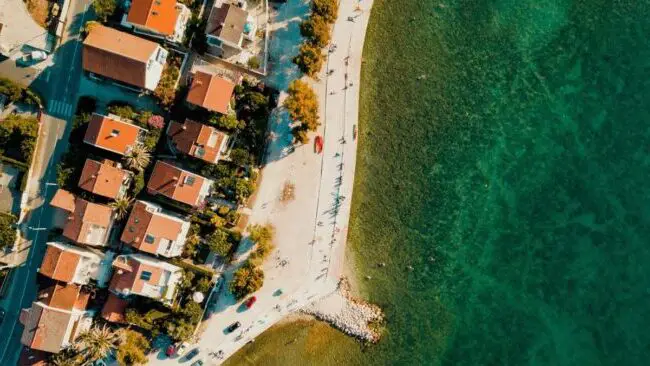Planning a visit to Zadar? Wondering when the worst time to go is? Well, let’s dive right into it and address your concern. Zadar, known for its stunning sunsets, historical sites, and vibrant atmosphere, has a lot to offer year-round. However, there are certain periods when it may not be the ideal time to visit.
We’ll explore these times and shed some light on why they might not be the most favorable for your trip. So, let’s get started and find out when to avoid Zadar if you want to make the most of your experience.
Table of Contents
Worst Time to Visit Zadar: Exploring the Off-Season Challenges
Zadar, a beautiful coastal city located in Croatia, has become a popular tourist destination in recent years. Its historic charm, vibrant culture, and stunning landscapes make it an ideal vacation spot. However, like any other travel destination, Zadar also has its drawbacks during certain times of the year. In this article, we will delve into the worst time to visit Zadar, highlighting the challenges travelers may face and providing insights to help you plan your trip accordingly.
1. Weather Conditions
When it comes to deciding the best time to visit Zadar, weather plays a crucial role. The worst time to visit Zadar is during the winter months, particularly from December to February. The city experiences cold and wet weather during this time, with temperatures dropping to around 6-10 degrees Celsius (43-50 degrees Fahrenheit). Rainfall is also quite frequent, making outdoor activities less enjoyable.
While some travelers may appreciate the quiet ambiance and the festive decorations during the holiday season, it’s important to be prepared for colder and wetter conditions.
2. Limited Outdoor Activities
Zadar offers a plethora of outdoor activities to enjoy, from exploring the historic Old Town to exploring the nearby national parks and islands. However, visiting Zadar during the worst time of the year means facing limited choices in terms of outdoor activities. The winter season restricts access to some attractions and natural wonders. National parks, such as Plitvice Lakes National Park and Krka National Park, may have reduced visiting hours or even be partially closed. The Adriatic Sea is also less inviting for water-based activities, such as swimming and sailing, due to the cooler temperatures.
3. Reduced Tourist Facilities
Another challenge of visiting Zadar during the worst time is that many tourist facilities operate on reduced schedules or might be closed altogether. Hotels, restaurants, and other amenities often have limited availability during the off-season. This can affect the overall quality of your travel experience, as you might not have access to certain services or accommodations. It’s advisable to check the availability of hotels, restaurants, and attractions in advance and plan accordingly if you decide to visit during the off-season.
4. Fewer Cultural Events
Zadar is known for its vibrant cultural scene, with numerous festivals and events taking place throughout the year. Unfortunately, the worst time to visit Zadar is also characterized by a lack of cultural events. Most festivals and concerts occur during the summer months when the city is bustling with tourists and locals. If you’re interested in immersing yourself in Zadar’s cultural offerings, it’s best to plan your visit during the peak season when these events are in full swing.
5. Limited Transportation Options
During the off-season, you may encounter limited transportation options in Zadar. Flights, especially those operated by low-cost airlines, may be reduced or even canceled altogether. This can make finding affordable and convenient travel arrangements more challenging. Additionally, public transportation schedules, such as buses and ferries, may be less frequent, potentially affecting your ability to explore surrounding areas or plan day trips.
6. Quieter Atmosphere
While some travelers seek solitude and tranquility, others enjoy the vibrant atmosphere of a bustling city. Zadar experiences a noticeable decrease in tourist activity during the worst time to visit. The city’s streets, cafes, and attractions are likely to be quieter and less lively. If you prefer a vibrant and energetic ambiance, it’s advisable to avoid visiting during the off-season.
7. Higher Chance of Unpredictable Events
The worst time to visit Zadar coincides with the winter season, which brings a higher chance of unpredictable events, such as storms or heavy rainfall. These events can disrupt travel plans and limit your ability to explore and enjoy the city. It’s essential to stay informed about weather conditions and have a backup plan in case unexpected events occur.
In conclusion, Zadar, with its rich history and stunning landscapes, is a wonderful travel destination. However, it’s important to consider the challenges associated with visiting during the worst time of the year. The winter season brings colder temperatures, limited outdoor activities, reduced tourist facilities, fewer cultural events, and potential disruptions due to unpredictable weather. If you prioritize a lively atmosphere, convenient transportation, and a wide range of activities, it’s best to plan your visit to Zadar during the peak season. Proper preparation and research will ensure a more enjoyable and fulfilling experience in this beautiful Croatian city.
25 Reasons You Should NEVER Visit Croatia
Frequently Asked Questions (FAQs)
The worst time to visit Zadar is during the winter months, from December to February. The city experiences cold temperatures, strong winds, and limited sunlight during this time. Many attractions and activities are also closed or have reduced hours.
Yes, Zadar experiences a rainy season from October to November. The rainfall increases during these months, making it less ideal for outdoor activities. It is advisable to bring suitable rain gear if visiting during this time.
While Zadar hosts several vibrant festivals and events throughout the year, it is recommended to avoid the peak holiday season, especially in July and August. During this time, the city becomes crowded with tourists, making it challenging to explore and enjoy its attractions fully.
Zadar generally experiences mild weather, but it can be subject to occasional strong winds, especially during the winter months. These winds, known as the bura, can reach high speeds and may affect outdoor activities, particularly on the coast.
Zadar is not particularly prone to natural disasters. However, it is always advisable to stay updated on weather forecasts and follow any instructions or warnings provided by local authorities, especially during periods of heavy rains or stormy weather.
To avoid large tourist crowds, it is best to avoid visiting Zadar in July and August, which are the peak months for tourism. These months coincide with the summer vacation period for many European countries, leading to more crowded attractions and higher prices.
Zadar, like other coastal regions, may experience water shortages during dry summer months, especially if there has been a prolonged period without rainfall. Visitors are encouraged to use water responsibly and be mindful of the local water conservation efforts.
Zadar can experience hot temperatures during the summer months of July and August. Daytime temperatures can often exceed 30 degrees Celsius (86 degrees Fahrenheit). It is advisable to stay hydrated, seek shade, and wear appropriate clothing during this time.
Final Thoughts
The worst time to visit Zadar is during the winter months, specifically from December to February. The city experiences cold temperatures and frequent rainfall during this period, making it less enjoyable for outdoor activities and sightseeing. Additionally, many tourist attractions and restaurants may have limited operating hours or be closed altogether.
If you’re looking to visit Zadar, it’s best to avoid the winter season and plan your trip during the spring or summer when the weather is more pleasant and vibrant.






